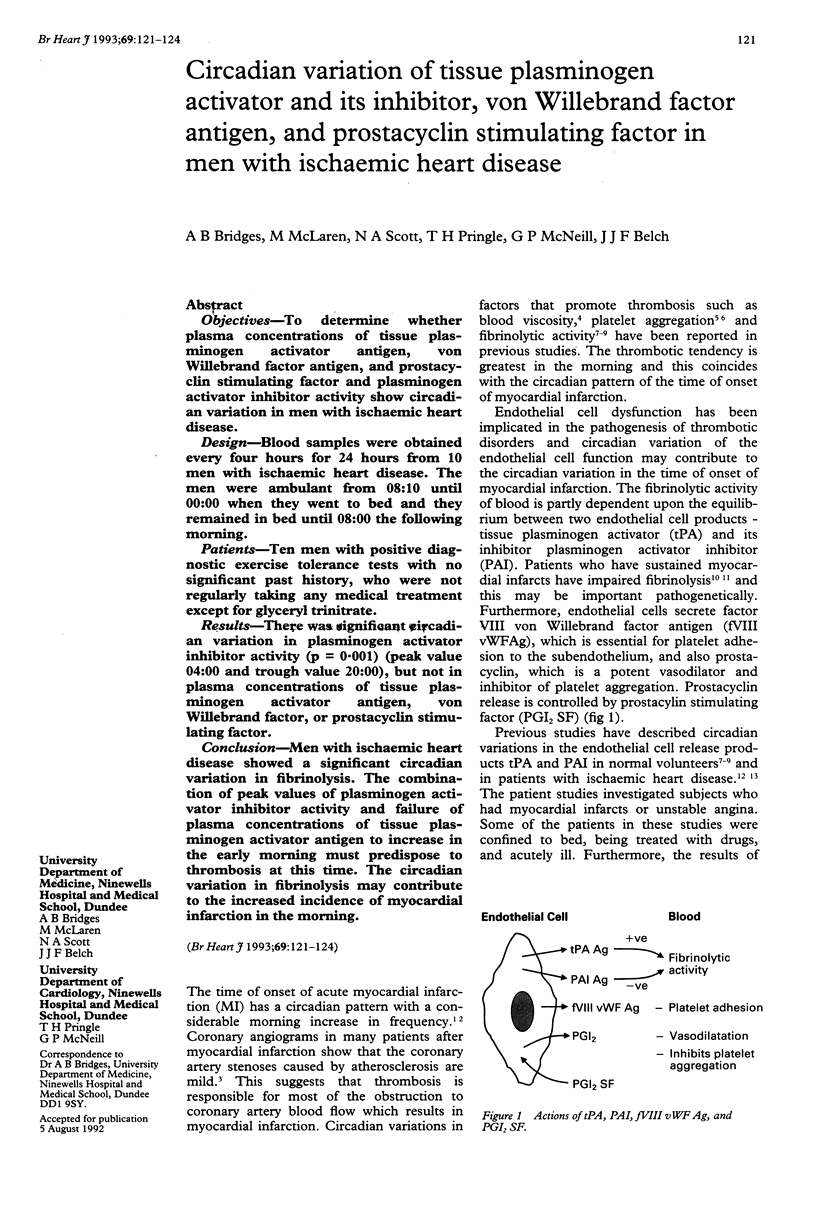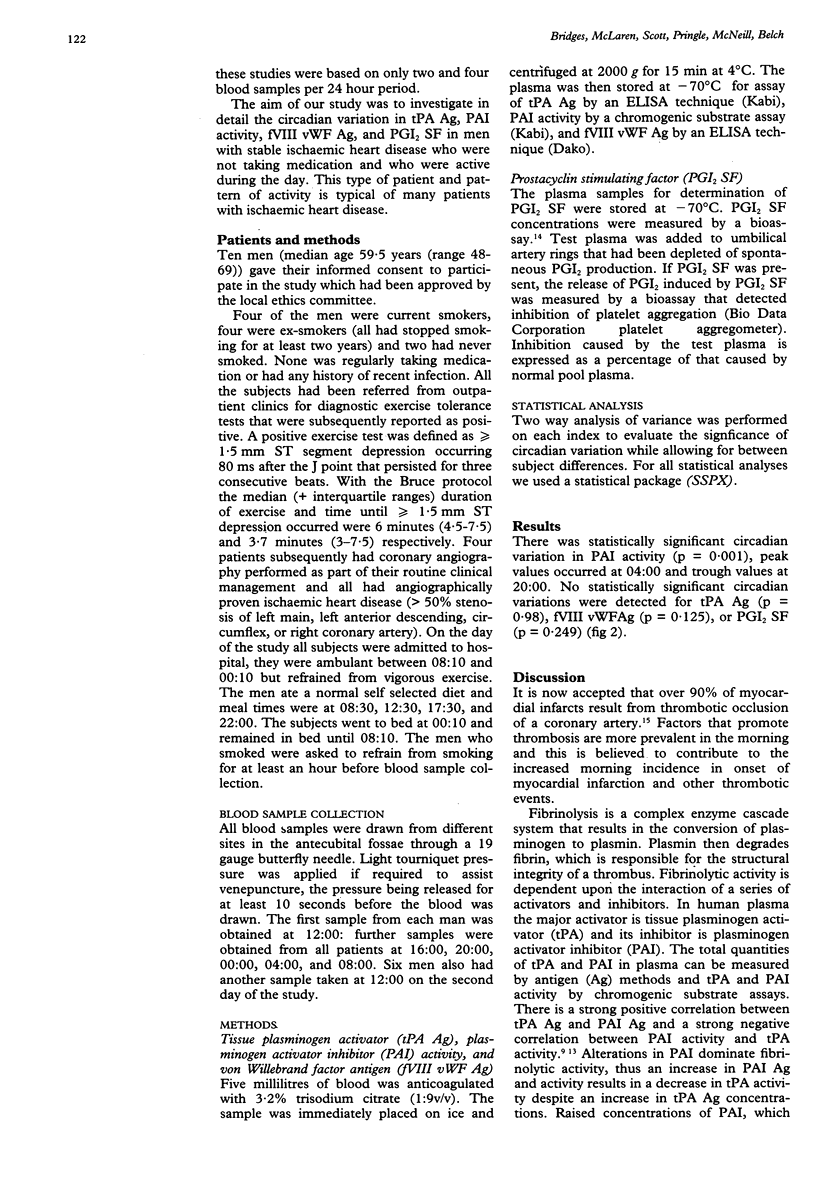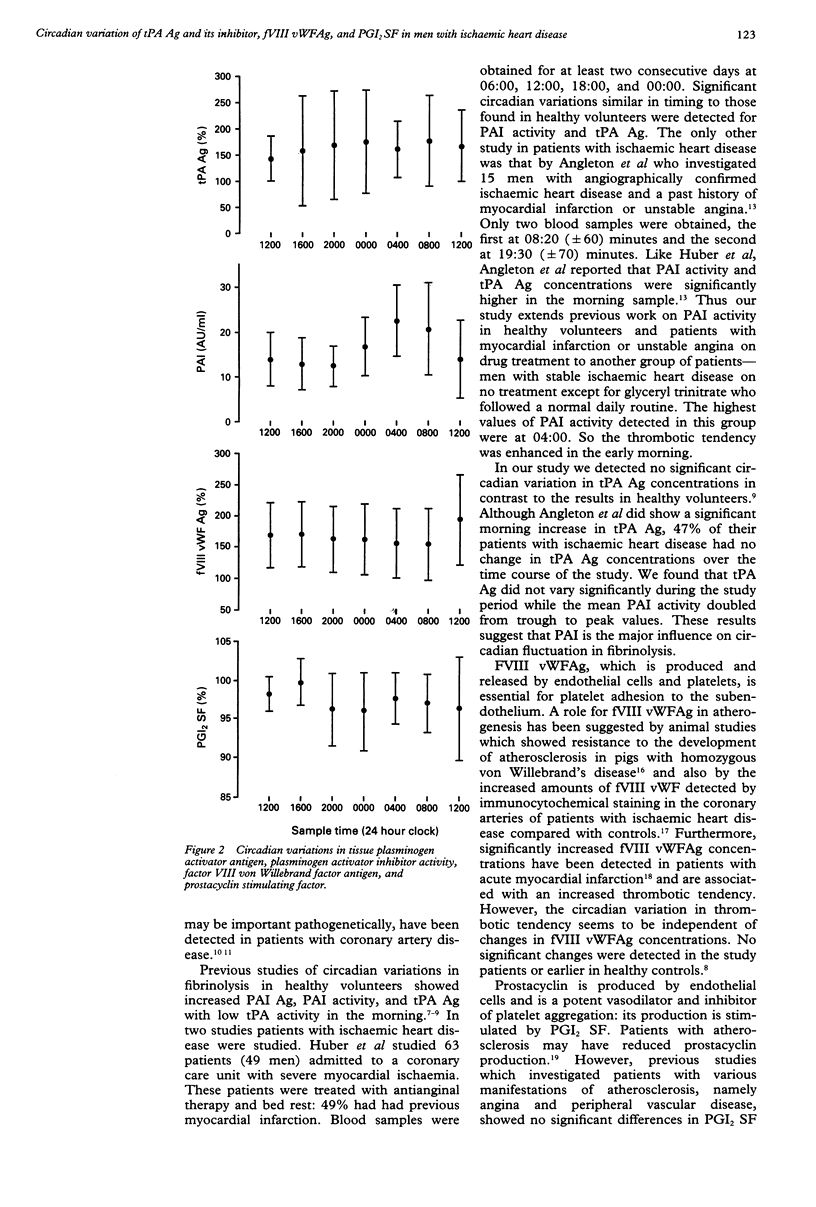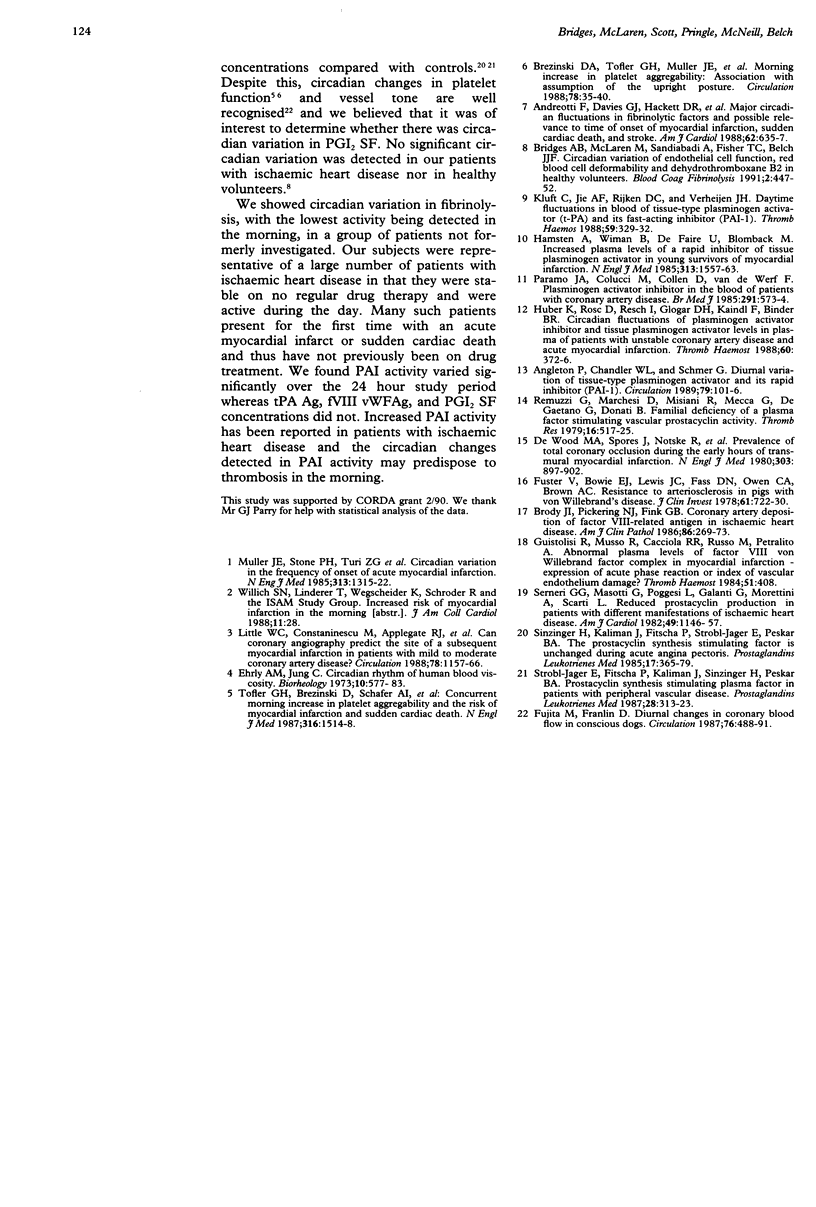Abstract
OBJECTIVES--To determine whether plasma concentrations of tissue plasminogen activator antigen, von Willebrand factor antigen, and prostacyclin stimulating factor and plasminogen activator inhibitor activity show circadian variation in men with ischaemic heart disease. DESIGN--Blood samples were obtained every four hours for 24 hours from 10 men with ischaemic heart disease. The men were ambulant from 08:10 until 00:00 when they went to bed and they remained in bed until 08:00 the following morning. PATIENTS--Ten men with positive diagnostic exercise tolerance tests with no significant past history, who were not regularly taking any medical treatment except for glyceryl trinitrate. RESULTS--There was significant circadian variation in plasminogen activator inhibitor activity (p = 0.001) (peak value 04:00 and trough value 20:00), but not in plasma concentrations of tissue plasminogen activator antigen, von Willebrand factor, or prostacyclin stimulating factor. CONCLUSION--Men with ischaemic heart disease showed a significant circadian variation in fibrinolysis. The combination of peak values of plasminogen activator inhibitor activity and failure of plasma concentrations of tissue plasminogen activator antigen to increase in the early morning must predispose to thrombosis at this time. The circadian variation in fibrinolysis may contribute to the increased incidence of myocardial infarction in the morning.
Full text
PDF



Selected References
These references are in PubMed. This may not be the complete list of references from this article.
- Andreotti F., Davies G. J., Hackett D. R., Khan M. I., De Bart A. C., Aber V. R., Maseri A., Kluft C. Major circadian fluctuations in fibrinolytic factors and possible relevance to time of onset of myocardial infarction, sudden cardiac death and stroke. Am J Cardiol. 1988 Sep 15;62(9):635–637. doi: 10.1016/0002-9149(88)90669-8. [DOI] [PubMed] [Google Scholar]
- Angleton P., Chandler W. L., Schmer G. Diurnal variation of tissue-type plasminogen activator and its rapid inhibitor (PAI-1). Circulation. 1989 Jan;79(1):101–106. doi: 10.1161/01.cir.79.1.101. [DOI] [PubMed] [Google Scholar]
- Brezinski D. A., Tofler G. H., Muller J. E., Pohjola-Sintonen S., Willich S. N., Schafer A. I., Czeisler C. A., Williams G. H. Morning increase in platelet aggregability. Association with assumption of the upright posture. Circulation. 1988 Jul;78(1):35–40. doi: 10.1161/01.cir.78.1.35. [DOI] [PubMed] [Google Scholar]
- Bridges A. B., McLaren M., Saniabadi A., Fisher T. C., Belch J. J. Circadian variation of endothelial cell function, red blood cell deformability and dehydro-thromboxane B2 in healthy volunteers. Blood Coagul Fibrinolysis. 1991 Jun;2(3):447–452. doi: 10.1097/00001721-199106000-00007. [DOI] [PubMed] [Google Scholar]
- Brody J. I., Pickering N. J., Fink G. B. Coronary artery deposition of factor VIII-related antigen in ischemic heart disease. Am J Clin Pathol. 1986 Sep;86(3):269–273. doi: 10.1093/ajcp/86.3.269. [DOI] [PubMed] [Google Scholar]
- DeWood M. A., Spores J., Notske R., Mouser L. T., Burroughs R., Golden M. S., Lang H. T. Prevalence of total coronary occlusion during the early hours of transmural myocardial infarction. N Engl J Med. 1980 Oct 16;303(16):897–902. doi: 10.1056/NEJM198010163031601. [DOI] [PubMed] [Google Scholar]
- Ehrly A. M., Jung G. Circadian rhythm of human blood viscosity. Biorheology. 1973 Dec;10(4):577–583. doi: 10.3233/bir-1973-10411. [DOI] [PubMed] [Google Scholar]
- Fujita M., Franklin D. Diurnal changes in coronary blood flow in conscious dogs. Circulation. 1987 Aug;76(2):488–491. doi: 10.1161/01.cir.76.2.488. [DOI] [PubMed] [Google Scholar]
- Fuster W., Bowie E. J., Lewis J. C., Fass D. N., Owen C. A., Jr, Brown A. L. Resistance to arteriosclerosis in pigs with von Willebrand's disease. Spontaneous and high cholesterol diet-induced arteriosclerosis. J Clin Invest. 1978 Mar;61(3):722–730. doi: 10.1172/JCI108985. [DOI] [PMC free article] [PubMed] [Google Scholar]
- Giustolisi R., Musso R., Cacciola E., Cacciola R. R., Russo M., Petralito A. Abnormal plasma levels of factor VIII/von Willebrand factor complex in myocardial infarction--expression of acute phase reaction or index of vascular endothelium damage? Thromb Haemost. 1984 Jul 29;51(3):408–408. [PubMed] [Google Scholar]
- Hamsten A., Wiman B., de Faire U., Blombäck M. Increased plasma levels of a rapid inhibitor of tissue plasminogen activator in young survivors of myocardial infarction. N Engl J Med. 1985 Dec 19;313(25):1557–1563. doi: 10.1056/NEJM198512193132501. [DOI] [PubMed] [Google Scholar]
- Huber K., Rosc D., Resch I., Schuster E., Glogar D. H., Kaindl F., Binder B. R. Circadian fluctuations of plasminogen activator inhibitor and tissue plasminogen activator levels in plasma of patients with unstable coronary artery disease and acute myocardial infarction. Thromb Haemost. 1988 Dec 22;60(3):372–376. [PubMed] [Google Scholar]
- Kluft C., Jie A. F., Rijken D. C., Verheijen J. H. Daytime fluctuations in blood of tissue-type plasminogen activator (t-PA) and its fast-acting inhibitor (PAI-1). Thromb Haemost. 1988 Apr 8;59(2):329–332. [PubMed] [Google Scholar]
- Little W. C., Constantinescu M., Applegate R. J., Kutcher M. A., Burrows M. T., Kahl F. R., Santamore W. P. Can coronary angiography predict the site of a subsequent myocardial infarction in patients with mild-to-moderate coronary artery disease? Circulation. 1988 Nov;78(5 Pt 1):1157–1166. doi: 10.1161/01.cir.78.5.1157. [DOI] [PubMed] [Google Scholar]
- Muller J. E., Stone P. H., Turi Z. G., Rutherford J. D., Czeisler C. A., Parker C., Poole W. K., Passamani E., Roberts R., Robertson T. Circadian variation in the frequency of onset of acute myocardial infarction. N Engl J Med. 1985 Nov 21;313(21):1315–1322. doi: 10.1056/NEJM198511213132103. [DOI] [PubMed] [Google Scholar]
- Paramo J. A., Colucci M., Collen D., van de Werf F. Plasminogen activator inhibitor in the blood of patients with coronary artery disease. Br Med J (Clin Res Ed) 1985 Aug 31;291(6495):573–574. doi: 10.1136/bmj.291.6495.573. [DOI] [PMC free article] [PubMed] [Google Scholar]
- Remuzzi G., Marchesi D., Misiani R., Mecca G., de Gaetano G., Donati M. B. Familial deficiency of a plasma factor stimulating vascular prostacyclin activity. Thromb Res. 1979;16(3-4):517–525. doi: 10.1016/0049-3848(79)90098-7. [DOI] [PubMed] [Google Scholar]
- Serneri G. G., Masotti G., Poggesi L., Galanti G., Morettini A., Scarti L. Reduced prostacyclin production in patients with different manifestations of ischemic heart disease. Am J Cardiol. 1982 Apr 1;49(5):1146–1151. doi: 10.1016/0002-9149(82)90038-8. [DOI] [PubMed] [Google Scholar]
- Sinzinger H., Kaliman J., Fitscha P., Strobl-Jäger E., Peskar B. A. The prostacyclin synthesis stimulating plasma factor is unchanged during acute angina pectoris. Prostaglandins Leukot Med. 1985 Mar;17(3):365–379. doi: 10.1016/0262-1746(85)90128-3. [DOI] [PubMed] [Google Scholar]
- Strobl-Jäger E., Fitscha P., Kaliman J., Sinzinger H., Peskar B. A. Prostacyclin synthesis stimulating plasma factor in patients with peripheral vascular disease. Prostaglandins Leukot Med. 1987 Aug;28(3):313–323. doi: 10.1016/0262-1746(87)90120-x. [DOI] [PubMed] [Google Scholar]
- Tofler G. H., Brezinski D., Schafer A. I., Czeisler C. A., Rutherford J. D., Willich S. N., Gleason R. E., Williams G. H., Muller J. E. Concurrent morning increase in platelet aggregability and the risk of myocardial infarction and sudden cardiac death. N Engl J Med. 1987 Jun 11;316(24):1514–1518. doi: 10.1056/NEJM198706113162405. [DOI] [PubMed] [Google Scholar]


